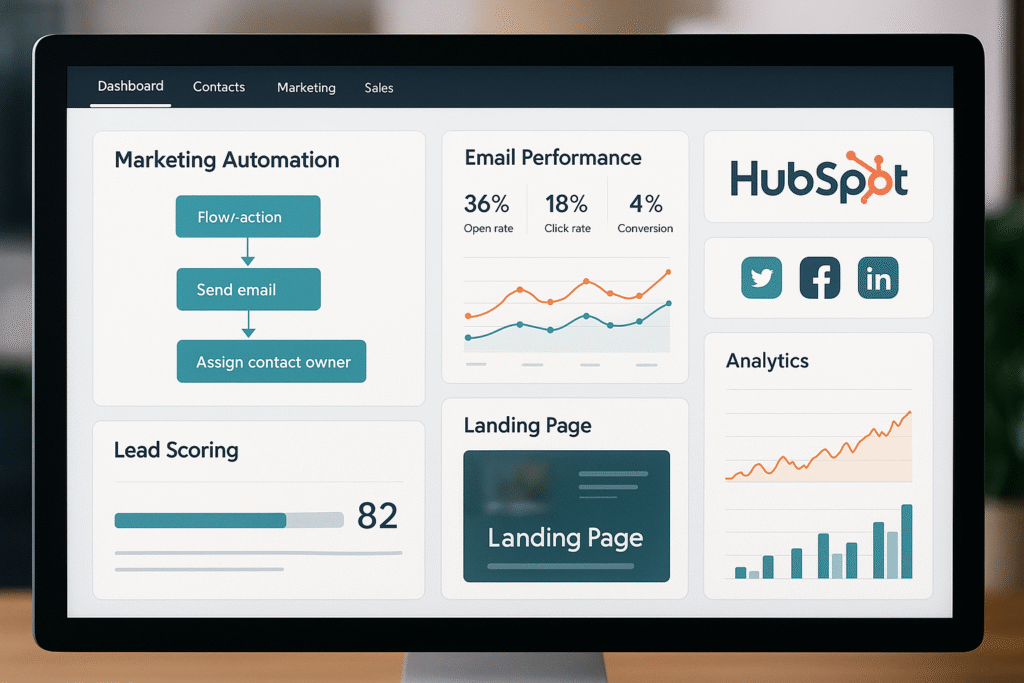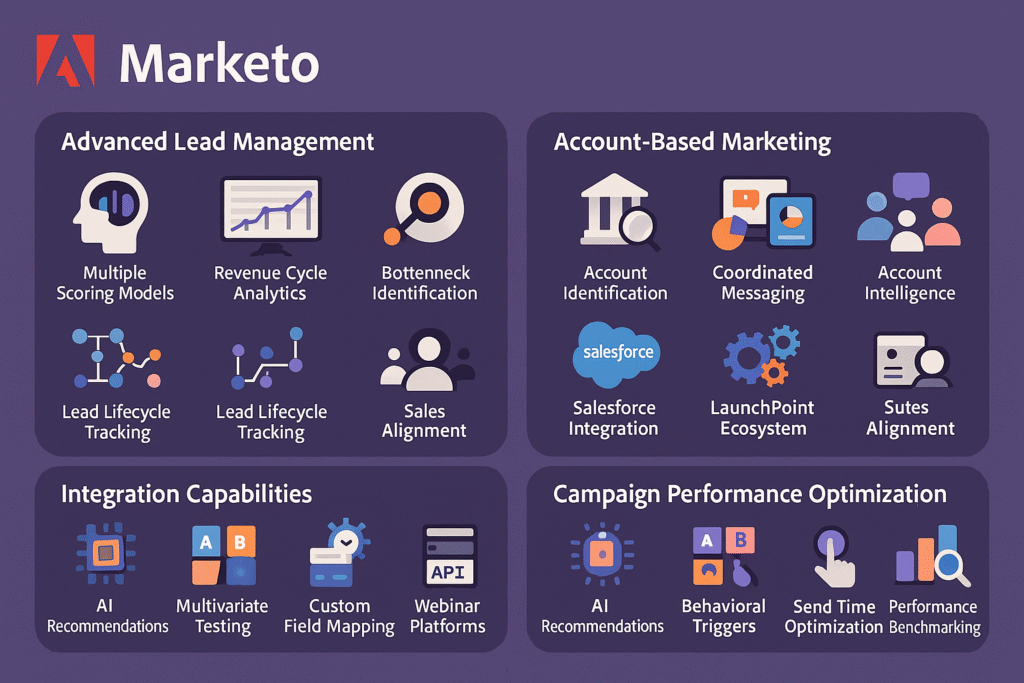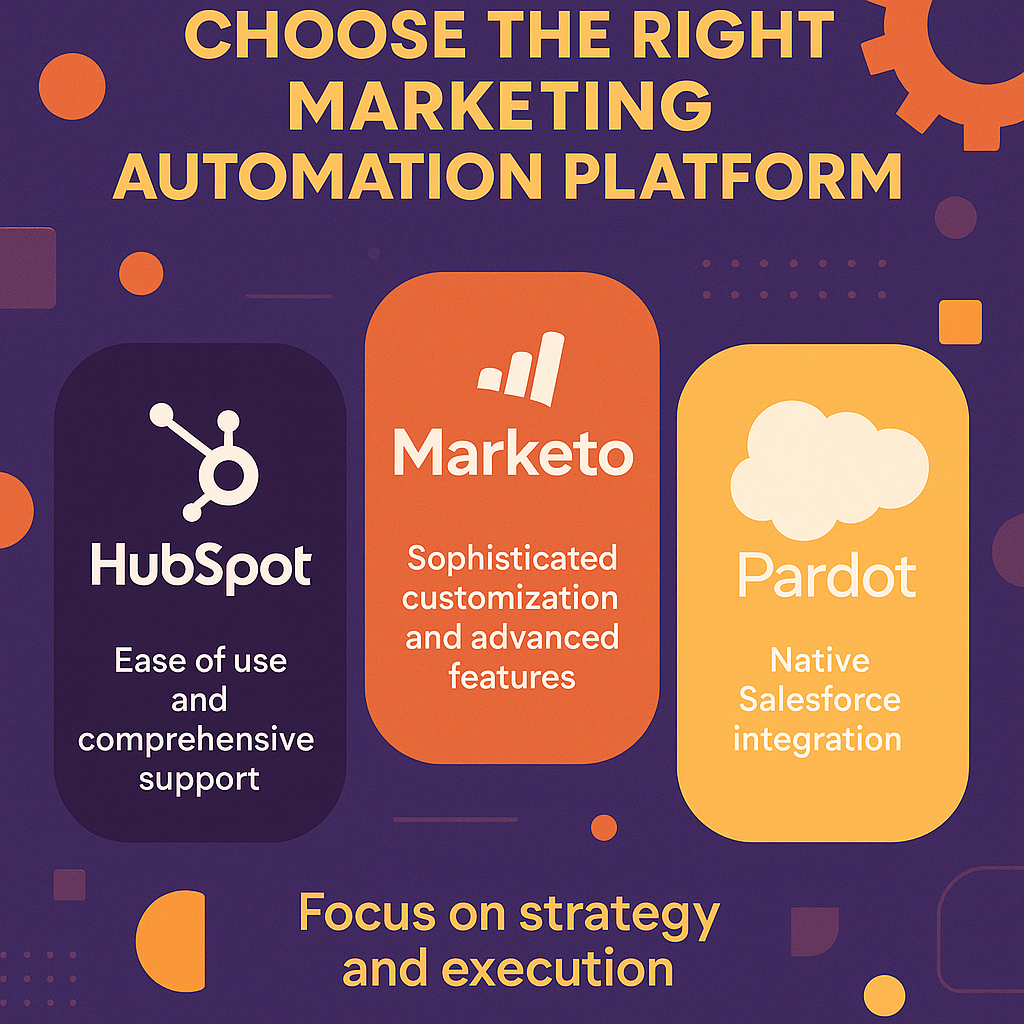Table of Contents
Marketing automation has become the backbone of modern digital marketing strategies. Businesses spend over 80% of their marketing budget on campaigns that fail to deliver expected results simply because they lack proper automation tools. The right platform can transform scattered marketing efforts into streamlined, revenue-generating machines.
Choosing between HubSpot, Marketo, and Pardot often feels overwhelming. Each platform promises exceptional results, but which one actually delivers for your specific business needs? This detailed comparison breaks down everything needed to make an informed decision about these leading automation platforms.
What is Marketing Automation?
Marketing automation refers to software platforms designed to automate repetitive marketing tasks and workflows. These tools help businesses nurture leads, personalize customer experiences, and measure campaign performance without constant manual intervention.
The technology works by tracking customer behavior across multiple touchpoints. When someone visits a website, downloads content, or opens an email, the system records these actions. Based on predefined rules, the platform automatically triggers relevant follow-up actions like sending targeted emails or assigning leads to sales teams.
Modern automation platforms integrate with CRM systems to create seamless customer journeys. This integration ensures marketing and sales teams work with the same data, reducing friction and improving conversion rates.
How Marketing Automation Works?
Marketing automation platforms operate through trigger-based workflows. These workflows consist of conditions, actions, and delays that create personalized customer experiences at scale.
The process begins when a prospect takes a specific action. This could be filling out a form, clicking an email link, or visiting a pricing page. The system immediately evaluates this action against established criteria and determines the next appropriate step.
For example, when someone downloads a whitepaper about email marketing, the system might wait 24 hours, then send a follow-up email with related case studies. If they engage with that email, they receive another message with a free consultation offer. If they don’t engage, they enter a different nurturing sequence designed for less active prospects.
Advanced platforms use machine learning to optimize these workflows automatically. They analyze which messages perform best, what timing generates higher engagement, and which content resonates with different audience segments.
Key Benefits of Marketing Automation
Improved Lead Nurturing
Automation platforms excel at maintaining consistent communication with prospects throughout long sales cycles. Instead of relying on sales teams to manually follow up with every lead, the system handles initial nurturing automatically.
This approach ensures no leads fall through the cracks. Studies show that companies using marketing automation see 451% more qualified leads than those relying solely on manual processes. The key lies in delivering relevant content at precisely the right moments.
Enhanced Personalization at Scale
Modern buyers expect personalized experiences, but delivering customized messages to thousands of prospects manually is impossible. Marketing automation solves this challenge by using customer data to personalize emails, website content, and offers automatically.
Platforms track individual preferences, behavior patterns, and engagement history to create unique experiences for each prospect. This level of personalization significantly improves conversion rates and customer satisfaction.
Better Campaign Performance Measurement
Traditional marketing campaigns often lack detailed performance insights. Automation platforms provide comprehensive analytics that show exactly which campaigns generate the most revenue, which channels perform best, and where improvements are needed.
These insights enable data-driven decision making. Marketers can quickly identify successful strategies and replicate them across other campaigns, while discontinuing tactics that don’t deliver results.
Time and Resource Efficiency
Marketing teams spend countless hours on repetitive tasks like sending follow-up emails, updating contact records, and scoring leads. Automation eliminates most of these manual processes, freeing up time for strategic activities.
This efficiency gain often translates directly to improved ROI. Teams can focus on creating better content, developing new strategies, and building stronger customer relationships instead of managing administrative tasks.
HubSpot Marketing Automation Platform

HubSpot has built its reputation on providing an integrated marketing, sales, and service platform that grows with businesses. The company started as an inbound marketing pioneer and has evolved into a comprehensive customer relationship management solution.
Core Features and Capabilities
HubSpot’s marketing automation offers comprehensive tools designed for businesses of all sizes:
Real-time Notifications: Sales teams receive instant alerts when leads reach score thresholds.
Visual Workflow Builder: Drag-and-drop interface creates complex automation sequences without technical expertise.
Multi-trigger Workflows: Activate based on website behavior, email engagement, form submissions, and lifecycle changes.
Email Marketing Suite: A/B testing, personalization tokens, and responsive templates included.
Advanced Analytics: Track open rates, click-through rates, and conversion metrics across customer journeys.
Smart Lead Scoring: Automatic scoring adjustments based on demographic data and online behavior.
Landing Page and Form Builder
The platform’s content creation tools streamline lead generation efforts:
Form Analytics: Track completion rates and identify optimization opportunities.
Professional Templates: Conversion-optimized designs require no coding knowledge.
Mobile Responsive: All pages automatically adapt to different device sizes.
Built-in SEO Tools: On-page optimization features improve search visibility.
Smart Forms: Dynamic questions based on known visitor information.
Progressive Profiling: Gradual data collection improves user experience.
Social Media Management Integration
HubSpot includes comprehensive social media capabilities:
Team Collaboration: Multiple users can manage social accounts with approval workflows.
Multi-channel Publishing: Schedule content across Facebook, Twitter, LinkedIn, and Instagram.
Social Listening: Monitor brand mentions and relevant industry conversations.
Engagement Tracking: Measure social activities’ contribution to marketing goals.
Automated Triggers: Social interactions can initiate follow-up sequences.
Social ROI Reporting: Connect social media efforts to revenue generation.
Analytics and Reporting
Detailed reporting capabilities provide actionable marketing insights:
Comparative Analytics: Benchmark performance across campaigns and time periods.
Attribution Reporting: Track how different channels contribute to revenue.
Customer Journey Mapping: Complete visibility from first touch to closed deal.
Custom Dashboards: Focus on metrics relevant to specific business goals.
Real-time Updates: Monitor campaign performance as it happens.
Revenue Attribution: Connect marketing activities directly to sales results.
Marketo Marketing Automation Platform

Adobe acquired Marketo in 2018, integrating it into their Experience Cloud suite. The platform focuses on sophisticated lead management and account-based marketing capabilities, making it popular among enterprise organizations with complex sales processes.
Marketo provides sophisticated lead management capabilities for enterprise organizations:
Multiple Scoring Models: Run different scoring systems simultaneously based on product interest or geography.
Revenue Cycle Analytics: Detailed insights into lead progression through conversion stages.
Bottleneck Identification: Pinpoint exactly where leads get stuck in the sales process.
Smart Lead Routing: Automatic assignment based on territory, expertise, or current workload.
Lead Lifecycle Tracking: Monitor prospects from awareness through customer retention.
Predictive Analytics: AI-powered insights predict which leads are most likely to convert.
Account-Based Marketing Features
Enterprise-focused ABM tools target high-value accounts effectively:
Account Identification: Automatically identify key stakeholders within target companies.
Coordinated Messaging: Consistent communication across all touchpoints and channels.
Account Intelligence: Aggregate engagement data from all contacts within organizations.
Personalized Campaigns: Tailor content specifically for individual target accounts.
Multi-stakeholder Tracking: Monitor engagement from multiple decision-makers.
Sales Alignment: Provide comprehensive account insights to sales teams.
Integration Capabilities
Marketo connects seamlessly with enterprise software ecosystems:
Salesforce Integration: Bidirectional sync maintains data consistency across systems.
LaunchPoint Ecosystem: Over 300 third-party application connections available.
Custom Field Mapping: Maintain existing data structures while adding automation.
API Access: Build custom integrations for unique business requirements.
Webinar Platforms: Native connections with major event management systems.
Advertising Networks: Direct integration with Google Ads, Facebook, and LinkedIn.
Campaign Performance Optimization
Machine learning drives continuous campaign improvements:
Performance Benchmarking: Compare campaigns against industry standards.
AI Recommendations: System suggests optimization opportunities based on performance patterns.
Multivariate Testing: Test multiple variables simultaneously for optimal combinations.
Behavioral Triggers: Activate campaigns based on specific prospect actions.
Send Time Optimization: AI determines best delivery times for individual recipients.
Content Personalization: Dynamic content adapts based on prospect characteristics.
Pardot Marketing Automation Platform
Salesforce Pardot (now called Marketing Cloud Account Engagement) was designed specifically for B2B marketing teams working within the Salesforce ecosystem. The platform emphasizes lead qualification and sales enablement through tight CRM integration.
Salesforce Native Integration

Pardot’s seamless CRM integration creates unified marketing and sales operations:
Workflow Automation: Trigger sales processes based on marketing engagement.
No Setup Required: Data flows automatically between marketing and sales systems.
Unified Contact Records: Complete marketing interaction history visible in Salesforce.
Real-time Sync: Changes in either system immediately reflect across platforms.
Sales Activity Tracking: Marketing teams see which activities lead to sales conversations.
Elimination of Data Silos: Both teams work with identical prospect information.
Lead Scoring and Grading
The dual qualification system provides comprehensive prospect evaluation:
Sales Prioritization: Help sales teams focus on highest-potential prospects.
Engagement Scoring: Measures prospect interest based on marketing interactions.
Demographic Grading: Evaluates how well prospects fit ideal customer profiles.
Automatic Adjustments: Scores update based on email engagement and website behavior.
Negative Scoring: Reduces ratings when prospects show decreased interest.
Custom Criteria: Define scoring rules based on specific business requirements.
Progressive Profiling and Dynamic Content
Sophisticated personalization capabilities enhance user experiences:
Behavioral Adaptation: Content changes based on previous interaction patterns.
Gradual Data Collection: Build comprehensive profiles without overwhelming visitors.
Smart Form Fields: Different questions appear based on known information.
Dynamic Website Content: Personalized messaging based on visitor characteristics.
Industry-Specific Offers: Tailor calls-to-action for different market segments.
Role-Based Messaging: Customize content for different decision-maker types.
Engagement Studio
Visual workflow creation enables sophisticated nurturing campaigns:
Performance Analytics: Track effectiveness of individual workflow components.
Drag-and-Drop Builder: Create complex automation sequences without technical skills.
Multi-criteria Triggers: Base actions on CRM data, website activity, and external events.
Real-time Responses: Workflows adapt immediately to prospect behavior changes.
Custom Business Logic: Align automation with unique sales processes.
Testing Capabilities: A/B test different workflow paths for optimization.
Platform Comparison Analysis
| Feature | HubSpot | Marketo | Pardot |
|---|---|---|---|
| Ease of Use | Excellent | Moderate | Good |
| Pricing | Flexible | Enterprise | Mid-Market |
| CRM Integration | Native | Third-party | Native Salesforce |
| Learning Curve | Low | High | Moderate |
| Customization | Good | Excellent | Good |
Pricing and Value Considerations
- HubSpot offers the most flexible pricing structure with free and starter tiers that accommodate small businesses and growing organizations. The platform scales pricing based on contact database size and feature requirements.
- Marketo targets enterprise customers with pricing that reflects its sophisticated capabilities. The investment is significant but justified for organizations requiring advanced automation features and extensive customization options.
- Pardot pricing falls between HubSpot and Marketo, making it attractive for mid-market companies already using Salesforce. The native integration eliminates additional CRM costs and reduces implementation complexity.
Implementation and Onboarding
- HubSpot’s user-friendly interface enables faster implementation with minimal technical resources. The platform includes extensive educational resources and certification programs that help teams become productive quickly.
- Marketo implementations typically require dedicated project management and technical expertise. The platform’s flexibility comes with complexity that demands thorough planning and ongoing optimization.
- Pardot implementations benefit from existing Salesforce infrastructure but still require careful planning to align marketing processes with sales workflows. The learning curve is moderate for teams familiar with Salesforce conventions.
Scalability and Growth Support
All three platforms support business growth but in different ways.
- HubSpot excels at growing with businesses from startup to enterprise, offering upgrade paths that add functionality as needs expand.
- Marketo handles enterprise-scale complexity exceptionally well but may overwhelm smaller organizations with unnecessary features. The platform shines when businesses have sophisticated marketing requirements and dedicated technical resources.
- Pardot scales effectively within the Salesforce ecosystem, making it ideal for companies committed to Salesforce as their primary business platform. The integration benefits increase as organizations adopt additional Salesforce products.
Choosing the Right Platform for Your Business
Small to Medium Business Considerations
Growing businesses need platforms that provide immediate value without overwhelming complexity. HubSpot excels in this segment by offering intuitive tools that marketing generalists can master quickly.
The platform’s educational resources help small teams develop marketing expertise while implementing automation strategies. This combination of tool functionality and learning support accelerates results for resource-constrained organizations.
Cost predictability is crucial for smaller businesses. HubSpot’s transparent pricing and free tier options allow organizations to start small and scale investment as results demonstrate value.
Enterprise Requirements
Large organizations often require sophisticated customization and integration capabilities that justify higher platform investments. Marketo delivers the flexibility and power needed for complex marketing operations.
Enterprise marketing teams typically have specialized roles and technical resources that can maximize Marketo’s advanced features. The platform’s learning curve becomes less significant when teams include dedicated marketing operations professionals.
Global enterprises benefit from Marketo’s robust privacy and compliance features that address international regulatory requirements. These capabilities are essential for organizations operating across multiple jurisdictions.
Industry-Specific Considerations
Technology companies often gravitate toward HubSpot due to its strong inbound marketing heritage and developer-friendly features. The platform’s content management and SEO tools align well with software companies’ marketing strategies.
Manufacturing and professional services firms frequently choose Pardot for its account-based marketing capabilities and Salesforce integration. These industries typically have longer sales cycles that benefit from sophisticated lead nurturing.
Financial services and healthcare organizations may prefer Marketo for its advanced security and compliance features. These regulated industries require platforms that can demonstrate robust data protection and audit capabilities.
Conclusion
Marketing automation platform selection should align with current business needs while considering future growth requirements. Each platform offers distinct advantages that serve different organizational contexts effectively.
Companies prioritizing ease of use and comprehensive support should consider HubSpot. The platform provides excellent value for growing businesses that need immediate results without extensive technical resources.
Organizations requiring sophisticated customization and advanced features may find Marketo worth the additional investment. The platform excels in enterprise environments with dedicated marketing operations teams.
Businesses already committed to Salesforce should strongly consider Pardot for its native integration benefits. The combination eliminates data silos and creates seamless experiences for sales and marketing teams.
Success with any platform depends more on strategy and execution than specific tool selection. Focus on understanding customer needs, creating valuable content, and measuring results consistently. The right platform simply makes these activities more efficient and scalable.
Marketing automation represents a significant opportunity for businesses ready to modernize their customer engagement strategies. Choose the platform that best supports long-term growth objectives while addressing immediate operational needs. With proper implementation and ongoing optimization, any of these platforms can deliver substantial improvements in marketing effectiveness and revenue generation.
Frequently Asked Questions
What is the main difference between HubSpot and Marketo?
HubSpot focuses on ease of use and all-in-one functionality, making it ideal for small to medium businesses. Marketo offers more advanced customization and enterprise-level features but requires more technical expertise to implement and manage effectively.
Can I switch between platforms later if my needs change?
Yes, but platform migration requires careful planning and data preparation. Most businesses can successfully switch platforms, though the process involves some complexity in data migration, workflow recreation, and team retraining.
How long does it take to see results from marketing automation?
Most businesses see initial improvements in lead management and email performance within 30-60 days. Significant revenue impact typically requires 3-6 months as automated workflows mature and optimization efforts compound.
Do I need technical expertise to use these platforms?
HubSpot requires minimal technical knowledge and provides extensive training resources. Marketo benefits from dedicated technical resources or marketing operations expertise. Pardot falls somewhere between, especially for teams familiar with Salesforce.
What budget should I expect for marketing automation?
Platform costs range from free (HubSpot Starter) to several thousand dollars monthly for enterprise features. Additional costs include implementation, training, and ongoing optimization. Most businesses should budget 10-15% of marketing spend for automation tools and support.
